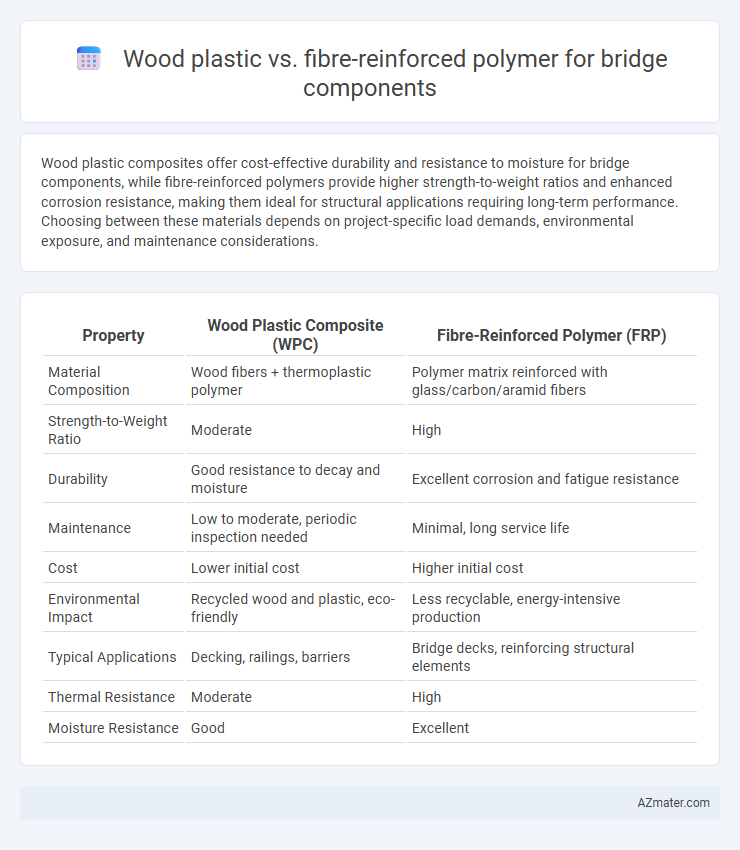Wood plastic composites offer cost-effective durability and resistance to moisture for bridge components, while fibre-reinforced polymers provide higher strength-to-weight ratios and enhanced corrosion resistance, making them ideal for structural applications requiring long-term performance. Choosing between these materials depends on project-specific load demands, environmental exposure, and maintenance considerations.
Table of Comparison
| Property | Wood Plastic Composite (WPC) | Fibre-Reinforced Polymer (FRP) |
|---|---|---|
| Material Composition | Wood fibers + thermoplastic polymer | Polymer matrix reinforced with glass/carbon/aramid fibers |
| Strength-to-Weight Ratio | Moderate | High |
| Durability | Good resistance to decay and moisture | Excellent corrosion and fatigue resistance |
| Maintenance | Low to moderate, periodic inspection needed | Minimal, long service life |
| Cost | Lower initial cost | Higher initial cost |
| Environmental Impact | Recycled wood and plastic, eco-friendly | Less recyclable, energy-intensive production |
| Typical Applications | Decking, railings, barriers | Bridge decks, reinforcing structural elements |
| Thermal Resistance | Moderate | High |
| Moisture Resistance | Good | Excellent |
Introduction to Bridge Component Materials
Wood plastic composites (WPCs) offer high durability and resistance to moisture, making them suitable for bridge decks and railing components, while fibre-reinforced polymers (FRPs) provide superior strength-to-weight ratios and corrosion resistance critical for structural elements like beams and girders. FRPs, composed of fibers such as glass, carbon, or aramid embedded in polymer matrices, excel in load-bearing capacity and fatigue resistance, extending bridge lifespan under dynamic stresses. Selection between WPCs and FRPs depends on factors like environmental exposure, mechanical requirements, maintenance costs, and lifecycle performance in bridge construction and rehabilitation.
Overview of Wood Plastic Composites (WPC)
Wood Plastic Composites (WPC) combine wood fibers and thermoplastics, offering enhanced durability and resistance to moisture compared to traditional wood. WPC materials exhibit high strength-to-weight ratios, making them suitable for bridge components exposed to environmental stress. Their resistance to rot, corrosion, and insect damage positions WPC as an eco-friendly alternative in infrastructure applications, balancing sustainability with structural performance.
Overview of Fibre-Reinforced Polymers (FRP)
Fibre-Reinforced Polymers (FRP) are composite materials made from a polymer matrix reinforced with fibers such as glass, carbon, or aramid, offering high strength-to-weight ratio and corrosion resistance. FRP components in bridge construction provide enhanced durability, reduced maintenance costs, and improved fatigue performance compared to traditional materials. Their application in bridge decks, girders, and reinforcements contributes to longer service life and adaptability to complex structural designs.
Mechanical Properties: Strength and Durability
Wood plastic composites exhibit moderate tensile strength and resistance to environmental degradation, making them suitable for light to medium load bridge components with good durability against moisture and UV exposure. Fibre-reinforced polymers (FRPs) provide superior mechanical strength, including high tensile and flexural strength, along with excellent fatigue resistance and corrosion immunity, ideal for high-load structural elements in bridges. The durability of FRPs in harsh environments surpasses wood plastic composites, ensuring longer service life with minimal maintenance in bridge applications.
Environmental Resistance: Weather, Rot, and Corrosion
Wood plastic composites (WPC) exhibit superior resistance to rot and insect attack compared to traditional wood, making them highly durable in humid and wet conditions for bridge components. Fibre-reinforced polymers (FRPs) offer exceptional weather resistance and corrosion immunity, especially against saltwater and chemical exposure, ensuring longevity in coastal and industrial environments. While WPC performs well against moisture-induced degradation, FRPs provide unmatched strength retention and minimal maintenance in environments prone to extreme weather fluctuations and chemical exposure.
Installation and Maintenance Requirements
Wood plastic composites (WPCs) offer easier installation in bridge components due to their lightweight nature and compatibility with standard fastening systems, reducing labor time and costs. Fibre-reinforced polymers (FRPs) require specialized installation techniques, including precise handling and curing processes, which can increase initial setup complexity. Maintenance for WPCs involves routine inspections for weathering and UV degradation, while FRPs demand less frequent maintenance but require monitoring for delamination and structural integrity under operational loads.
Cost Comparison: Initial and Lifecycle Analysis
Wood plastic composites (WPC) typically offer lower initial costs compared to fibre-reinforced polymers (FRP) due to cheaper raw materials and simpler manufacturing processes. Lifecycle cost analysis reveals FRP's higher upfront investment is offset by superior durability, corrosion resistance, and minimal maintenance requirements, reducing repair and replacement expenses over the bridge's lifespan. Studies indicate WPC may incur higher long-term costs from degradation and maintenance, while FRP presents a more economical solution for bridges with extended service life demands.
Sustainability and Environmental Impact
Wood plastic composites offer advantages in sustainability due to their use of recycled plastics and renewable wood fibers, reducing landfill waste and forest depletion. Fibre-reinforced polymers (FRPs), while highly durable and corrosion-resistant, often rely on non-renewable petrochemical resins, posing challenges in end-of-life recyclability and environmental impact. Both materials improve bridge longevity and reduce maintenance frequency, contributing to lower life-cycle carbon footprints compared to traditional materials like steel and concrete.
Case Studies and Real-world Applications
Wood plastic composites (WPCs) and fibre-reinforced polymers (FRPs) are extensively evaluated for bridge components in multiple case studies highlighting their durability and performance under real-world conditions. WPCs demonstrate superior resistance to moisture and biological decay in pedestrian bridge decks, as evidenced by installations such as the Timber Bridge in Oregon, while FRPs offer exceptional strength-to-weight ratios and corrosion resistance suitable for structural reinforcements, exemplified by the Almond Bridge in France. Comparative analyses reveal FRPs outperform WPCs in load-bearing applications, whereas WPCs provide cost-effective, low-maintenance alternatives for non-structural elements, optimizing lifecycle costs in diverse climatic environments.
Future Trends and Innovations in Bridge Materials
Wood plastic composites (WPC) and fibre-reinforced polymers (FRP) both represent advancing materials in bridge construction, with FRP showing superior strength-to-weight ratios and corrosion resistance. Future trends highlight the integration of nano-enhancements and hybrid composites to improve durability and load-bearing capacity, while smart sensing technologies embedded in FRP components enable real-time structural health monitoring. Innovations emphasize sustainability by optimizing recycled content in WPC and developing bio-based resins for FRP, pushing the forefront of eco-friendly, high-performance bridge materials.

Infographic: Wood plastic vs Fibre-reinforced polymer for Bridge component
 azmater.com
azmater.com